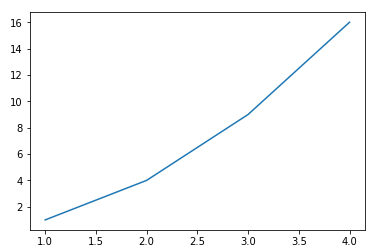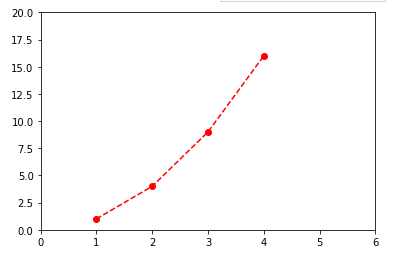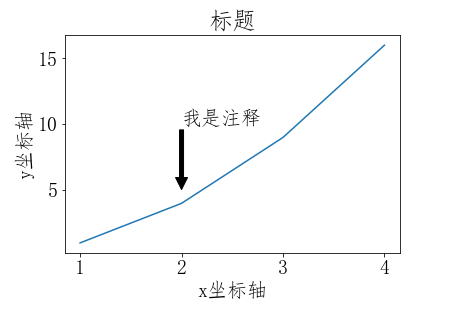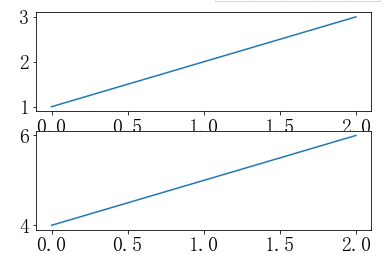pyplot官网教程https://matplotlib.org/users/pyplot_tutorial.html
#导入matplotlib的pyplot模块 import matplotlib.pyplot as plt
plot用于绘制线条
''' 第1步:定义x和y坐标轴上的点 ''' #x坐标轴上点的数值 x=[1, 2, 3, 4] #y坐标轴上点的数值 y=[1, 4, 9, 16] ''' 第2步:使用plot绘制线条 第1个参数是x的坐标值,第2个参数是y的坐标值 ''' plt.plot(x,y) ''' 第3步:显示图形 ''' plt.show()
设置线条属性,文档:https://matplotlib.org/api/_as_gen/matplotlib.lines.Line2D.html#matplotlib.lines.Line2D
''' color:线条颜色,值r表示红色(red) marker:点的形状,值o表示点为圆圈标记(circle marker) linestyle:线条的形状,值dashed表示用虚线连接各点 ''' plt.plot(x, y, color='r',marker='o',linestyle='dashed') #plt.plot(x, y, 'ro') ''' axis:坐标轴范围 语法为axis[xmin, xmax, ymin, ymax], 也就是axis[x轴最小值, x轴最大值, y轴最小值, y轴最大值] ''' plt.axis([0, 6, 0, 20]) plt.show()
如果matplotlib参入的参数只能是列表的话,这对数据处理很不利。
一般,我们传入的是numpy的数组。实际上,所有参入的值内部都会转换为numpy的数组。
''' # arange用于生成一个等差数组,arange([start, ]stop, [step, ] 使用见文档:https://docs.scipy.org/doc/numpy/reference/generated/numpy.arange.html ''' import numpy as np t = np.arange(0, 5, 0.2) t
''' 使用数组同时绘制多个线性 ''' #线条1 x1=y1=t ''' 运算符**,表示幂 - 返回x的y次幂,例如10**20表示10的20次方 详细见文档《Python3运算符》:http://www.runoob.com/python3/python3-basic-operators.html ''' #线条2 x2=x1 y2=t**2 #线条3 x3=x1 y3=t**3 #使用plot绘制线条 linesList=plt.plot(x1, y1, x2, y2, x3, y3 ) #用setp方法可以同时设置多个线条的属性 plt.setp(linesList, color='r') plt.show() print('返回的数据类型',type(linesList)) print('数据大小:',len(linesList))
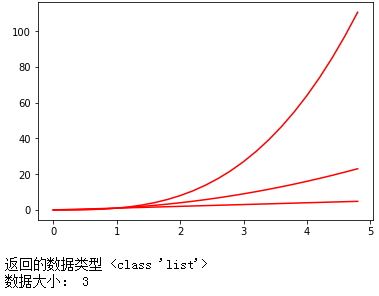
在图上添加文本
#找到 matplotlib 加载的配置文件路径 import matplotlib matplotlib.matplotlib_fname()
"""设置字体,用于显示中文""" plt.rcParams['font.sans-serif']=['FangSong'] """SimSun 宋体,Microsoft YaHei微软雅黑 YouYuan幼圆 FangSong仿宋""" plt.rcParams['font.size']=20 plt.rcParams['axes.unicode_minus']=False# 负号乱码
''' 第1步:定义x和y坐标轴上的点 ''' #x坐标轴上点的数值 x=[1, 2, 3, 4] #y坐标轴上点的数值 y=[1, 4, 9, 16] ''' 第2步:使用plot绘制线条 第1个参数是x的坐标值,第2个参数是y的坐标值 ''' plt.plot(x,y) ''' 添加文本 ''' #x轴文本 plt.xlabel('x坐标轴') #y轴文本 plt.ylabel('y坐标轴') #标题 plt.title('标题') #添加注释 ''' 添加注释: 参数名xy:箭头注释中箭头所在位置, 参数名xytext:注释文本所在位置, arrowprops在xy和xytext之间绘制箭头, shrink表示注释点与注释文本之间的图标距离 ''' plt.annotate('我是注释', xy=(2,5), xytext=(2, 10), arrowprops=dict(facecolor='black', shrink=0.01), ) ''' 第3步:显示图形 ''' plt.show()
多个图绘图
#创建画板1 fig = plt.figure(1) #第2步:创建画纸(子图) ''' subplot()方法里面传入的三个数字 前两个数字代表要生成几行几列的子图矩阵,第三个数字代表选中的子图位置 subplot(211)生成一个2行1列的子图矩阵,当前是第一个子图 ''' #创建画纸,并选择画纸1 #等价于ax1=fig.add_subplot(211) ax1=plt.subplot(2,1,1) #在画纸上绘图 plt.plot([1, 2, 3]) #选择画纸2 ax2=plt.subplot(2,1,2) #在画纸2上绘图 plt.plot([4, 5, 6]) plt.show()
如果没有指明画板figure()和子图subplot,会默认创建一个画板figure(1) 和一个子图subplot(111)
悟已往之不谏,知来者之可追。

